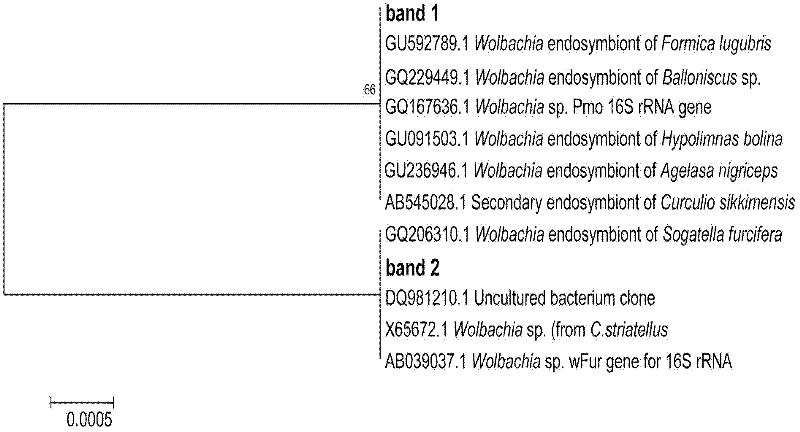Detection method of symbiotic Wolbachia bacteria in mymanidae bodies
A detection method, the technology of tassels, applied in the fields of biochemical equipment and methods, determination/inspection of microorganisms, etc.
- Summary
- Abstract
- Description
- Claims
- Application Information
AI Technical Summary
Problems solved by technology
Method used
Image
Examples
Embodiment
[0033] 1. The source of the gnats used in this implementation example is the rice lice. T1 and T2 are collected from Zhejiang, which are samples cultivated at different temperatures. P5 is collected from the paddy field of the Philippine International Rice Research Institute Experimental Farm. The collected samples are preserved Store in -72°C refrigerator for later use.
[0034] 2. Genomic DNA extraction: Take out the cryopreserved wasp sample and put it on a clean bench to thaw. Take 10 samples of each type of wasp and put them into sterile 2 ml centrifuge tubes, add 1 mL of 70% ethanol, shake gently for 5 min, then rinse with sterile water for 3 times, repeat this step 3 times to remove the bacteria on the surface of the rice lice wasps.
[0035] Genomic DNA was extracted from samples of A. oryzae with DNeasy Blood & Tissue Kit (purchased from Qiagen Corp.). Put the wasp sample with surface bacteria removed into a new sterile 2 mL centrifuge tube, add 180 μL of ATL buffer...
PUM
 Login to View More
Login to View More Abstract
Description
Claims
Application Information
 Login to View More
Login to View More - R&D
- Intellectual Property
- Life Sciences
- Materials
- Tech Scout
- Unparalleled Data Quality
- Higher Quality Content
- 60% Fewer Hallucinations
Browse by: Latest US Patents, China's latest patents, Technical Efficacy Thesaurus, Application Domain, Technology Topic, Popular Technical Reports.
© 2025 PatSnap. All rights reserved.Legal|Privacy policy|Modern Slavery Act Transparency Statement|Sitemap|About US| Contact US: help@patsnap.com



